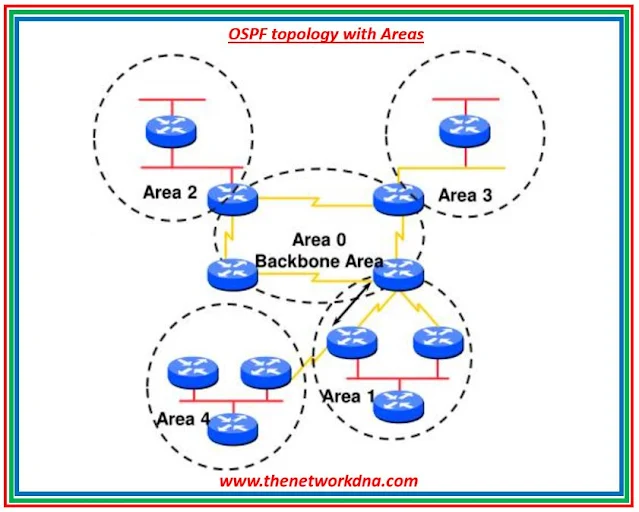Top OSPF Protocol Interview Questions and Answers
Top OSPF Protocol Interview Questions and Answers
Here are some top interview questions on OSPF protocol. Lets go through it one by one to understand more.
 |
| Fig 1.1- OSPF |
What is OSPF, and what is its primary purpose?
OSPF (Open Shortest Path First) is a link-state routing protocol used for determining the best path for routing packets within an IP network. Its main purpose is to provide efficient and dynamic routing in IP networks
What are the advantages of OSPF over distance vector protocols?
OSPF uses a link-state database and Dijkstra's algorithm for path selection, which results in faster convergence, better scalability, and loop prevention compared to distance vector protocols.
Explain the concept of OSPF areas?
OSPF divides a network into areas to improve scalability and reduce the amount of routing information exchanged. Areas are connected to the backbone area (Area 0), and routers summarize routes between areas.
How does OSPF elect the Designated Router (DR) and Backup Designated Router (BDR) on multi-access networks?
OSPF elects the DR and BDR based on the highest OSPF priority and the highest router ID. If priorities are equal, the router with the highest RID becomes the DR.
Describe the OSPF LSAs (Link-State Advertisements) and their functions?
- Type 1: Router LSA - Describes local router interfaces and their IP addresses.
- Type 2: Network LSA - Generated by the DR and describes the attached segment.
- Type 3: Summary LSA - Represents inter-area routes and is used for route summarization.
- Type 4: ASBR Summary LSA - Advertises ASBR (Autonomous System Border Router) locations.
- Type 5: External LSA - Represents routes redistributed into OSPF from external sources.
- Type 7: NSSA External LSA - Used in Not-So-Stubby Areas (NSSAs) for external routes.
How does OSPF establish neighbor relationships?
OSPF uses Hello packets exchanged between routers on the same subnet. If routers agree on parameters (hello/dead intervals, area ID, authentication), they become neighbors.
What is the purpose of OSPF Hello packets?
OSPF Hello packets are used for neighbor discovery, adjacency establishment, and maintaining neighbor relationships.
Explain LSDB (Link-State Database) synchronization?
LSDB synchronization ensures that OSPF routers have consistent link-state databases before exchanging routing updates, reducing the risk of transient routing loops during OSPF convergence.
What are the steps involved in OSPF convergence?
OSPF convergence involves neighbor discovery, database synchronization, route calculation using Dijkstra's algorithm, SPF tree creation, and updating the routing table.
How does OSPF perform route summarization?
OSPF summarizes routes at area boundaries, using Type 3 Summary LSAs to reduce the size of routing tables.
What is the purpose of OSPF route filtering?
OSPF route filtering allows administrators to control the exchange of routing information by applying Access Control Lists (ACLs) to OSPF processes.
What is a virtual link in OSPF?
A virtual link is used to connect an OSPF area to the backbone area (Area 0) through a non-backbone area.
Explain the concept of a stub area in OSPF?
A stub area blocks Type 5 External LSAs from entering the area, which reduces the size of the LSDB and routing table. The ABR generates Type 3 Summary LSAs for external routes.
How can OSPF be secured using authentication?
OSPF authentication is configured using plain text or MD5 authentication keys to ensure that OSPF Hello packets and LSAs are exchanged only between authenticated neighbors.
How does OSPFv3 differ from OSPFv2?
OSPFv3 is designed specifically for IPv6 networks and uses IPv6 addresses. It also simplifies OSPF operation by eliminating the need for DR/BDR elections on point-to-point links.
What are OSPFv3's IPv6 address types?
OSPFv3 uses Link-Local addresses (fe80::/10) for neighbor discovery and Global Unicast addresses (2000::/3) for routing and communication.
What commands can you use to troubleshoot OSPF?
Common troubleshooting commands include "show ip ospf," "show ip ospf neighbor," "show ip ospf database," and "debug ip ospf events."
How does OSPF interact with BGP?
OSPF can redistribute BGP routes into the OSPF routing domain, allowing BGP-learned routes to be advertised within the OSPF network.
Can OSPF and EIGRP coexist in the same network?
Yes, OSPF and EIGRP can coexist using redistribution. However, it's recommended to use route summarization and filtering to prevent routing loops.
What are the different OSPF authentication options, and how do they enhance security?
OSPF supports authentication using plaintext, MD5, and key chains. These options help prevent unauthorized routers from participating in OSPF and ensure data integrity.
Continue Reading...
- OSPF Show Commands on Cisco, Juniper, Huawei, HP and Arista Networks devices
- How to Optimize Your MPLS VPN with OSPF Sham-Link
- OSPF protocol : OSPF Packet Types
- OSPF NSSA Area introduction and Configuration
- Facts about DR and BDR selection in OSPF
- OSPF and BGP configuration setup on a vEdge Router
- OSPF Configuration Guide : OSPF Distance External Command Behavior
- A quick difference: OSPF Vs IS-IS Dynamic Routing Protocol
- Routing: Configuration OSPF To Filter Type-5 LSAs
- Introduction to OSPFv3 AS External LSA Route Calculation
- Differences between OSPFv3 and OSPFv2
- OSPF Over non-Broadcast Networks ( NBMA) basics and Configuration
- OSPF Configurations in Huawei Routers
- Quick tips to OSPF Routing Protocol for Network Engineers
- OSPF Basic configuration Step by step on Cisco Routers
- OSPF Basics : Simple points to study
- OSPF prefix-suppression- Configurations and Verification
- OSPF LSA-ID Conflict : %OSPF-4-CONFLICTING_LSAID
- Cisco IOS-XE: OSPF stuck in INIT - LLS TLV
- Configure Redistribution of iBGP Routes Into OSPF
- Cisco and Juniper Routers : OSPF point to multipoint configurations







